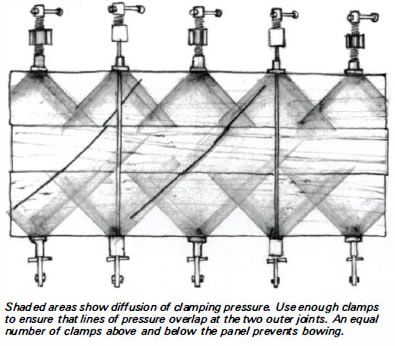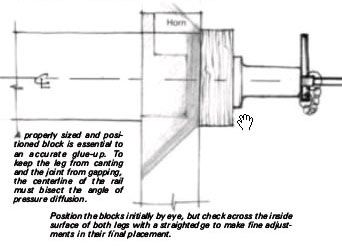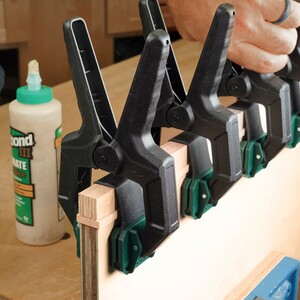Gluing Up: How to get a strong, square assembly

A misplaced caul could easily make your life a lot more difficult. Take your time and tape a caul right where you want it and your clamping pressure to be.
The Taunton Press recently re-released five books in our timeless Fine Woodworking On series. This classic series features collections of articles from the early days of the magazine.
Today I was thumbing through Fine Woodworking On Joinery, which has 36 articles about all things joinery including glues, decorative joinery, dovetail templates, mortise and tenon joinery and even clamps. One article in particular jumped out at me. Ian J. Kirby wrote a piece for the November/December of 1981 simply titled “Gluing Up“*.
Even though I was only six months old when this issue came out, the information in it is just as pertinent today as it was then. In particular this article speaks to me and many others who are just getting into the craft because it is based around readily available and usually affordable bar clamps. We all would love to have a full collection of parallel clamps. But if you’re like me, they just aren’t in the budget, or if you’re like Ian Kirby in 1981, they weren’t available at all yet.
I try and make my time in my shop as relaxing as possible. Designing, breaking down lumber, finessing joinery, and even surface preparation are times that I can listen to music or a podcast (I sure do love those Shop Talk Live boys) or even work in silence and think. When the glue starts flowing the tension goes up a notch (or ten) and I quickly start flailing around the shop like a chicken with my head cut off. Adding just a few minutes worth of glue up preparation to get cauls set up and clamps in order can keep you from chasing your tail or worse yet reaching for the drywall screws because a joint just didn’t come together.
Kirby stresses how the sizing of cauls and where they are placed make a big difference. I’ve been guilty of grabbing the nearest scrap on the floor and asking it to do nothing more than keeping my clamps from denting my project. In this article Kirby really drives home the fact that properly sized and properly placed cauls not only keep your clamps from denting your project but make sure that your joinery is tight and square.
This article and all of the articles in Fine Woodworking On Joinery are classics. Don’t let their vintage fool you. Wood today is the same as it was then and these techniques apply just as much today as they did back when they were written.
*To give you just a taste of the great articles you’ll find in Fine Woodworking On Joinery I’m going to make Ian Kirby’s Gluing Up article available for free for a week.




















Comments
Ben,
When I open the PDF on the iPad the last page is corrupted and unreadable. Should I use a PC instead?
Grant2 - Sorry about that. I'm seeing the same thing on my iPad. Opens fine on my mac so maybe that's the easiest course of action. I'll try and figure out why that happened. Thanks for the heads up!
Great information and presented in a way that is very user friendly with references and direct links. The corrupted last page was overcome by my having Fine Woodworking On Joinery in my collection.
Log in or create an account to post a comment.
Sign up Log in